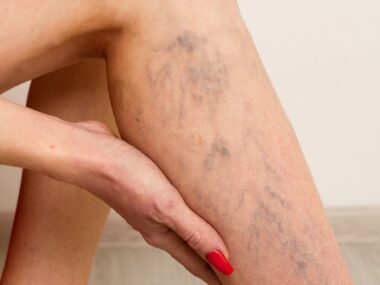It is unknown what specifically causes spider veins. Environment, genetics, or a combination of both may be to blame for the condition. The risk is also higher for some persons than for others.
Telangiectasia is a disorder where enlarged venules (tiny blood vessels) form threadlike red lines or patterns on the skin. These patterns, called telangiectases, develop gradually and frequently in groups. Since they have a delicate, weblike appearance, they are sometimes referred to as “spider veins.”
The lips, nose, eyes, fingers, and cheeks are just a few of the easily noticeable regions where telangiectases are common. Some individuals find them ugly, and they might be uncomfortable. Many folks decide to have them taken out. Removal is accomplished by damaging the vessel and pushing it to scar or collapse. The red patterns or marks on the skin look less visible as a result.
Despite the fact that telangiectases are mostly benign, they can indicate a dangerous condition. For instance, a rare genetic disorder called hereditary hemorrhagic telangiectasia (HHT) creates telangiectases that can be fatal. HHT-related telangiectases develop in critical organs like the liver rather than on the skin. They could rupture and cause severe bleeding (hemorrhages).
Knowing the Symptoms of Telangiectasia
It can be unpleasant to have telangiectases. Although they often pose little danger to life, some people might not like the way they appear. Health and beauty products that irritate the skin, including abrasive soaps and sponges, can exacerbate their gradual development.
Symptoms include:
- pain (related to pressure on venules)
- itching
- threadlike red marks or patterns on the skin
The symptoms of HHT include:
- frequent nosebleeds
- red or dark black blood in stools
- shortness of breath
- seizures
- small strokes
- port-wine stain birthmark
How Does Telangiectasia (Spider veins) Develop?
There is no known cause for telangiectasia. The development of spider veins, according to researchers, may result from a variety of factors. These factors could be hereditary, environmental, or a mix of the two. Most occurrences of telangiectasia are thought to be brought on by prolonged sun exposure or extremely high temperatures. This is due to the fact that they typically manifest on body parts with exposed skin to air and sunlight.
Other possible causes include:
- Alcoholism: can affect the flow of blood in vessels and can cause liver disease
- Pregnancy: often applies large amounts of pressure on venules
- Aging: aging blood vessels can begin to weaken
- Rosacea: enlarges venules in the face, creating a flushed appearance in cheeks and nose
- Habitual corticosteroid use: thins and weakens the skin
- Scleroderma: hardens and contracts the skin
- Dermatomyositis: inflames skin and underlying muscle tissue
- Systemic lupus erythematosus: can increase skin sensitivity to sunlight and extreme temperatures
Genetic factors are to blame for hereditary hemorrhagic telangiectasia. HHT is inherited from at least one parent in those who have it. Three of the five genes thought to be responsible for HHT are known. One defective gene is all that is required to cause HHT, therefore individuals with HHT either inherit one normal gene and one mutated gene or two mutated genes.
Who is Susceptible to Developing Telangiectasia?
Even in healthy individuals, telangiectasia is a frequent skin condition. But some people are more likely to get telangiectases than others. Included are those who:
- work outdoors
- sit or stand all day
- misuse alcohol
- are pregnant
- are older or elderly (telangiectases are more likely to form as skin ages)
- have rosacea, scleroderma, dermatomyositis, or systemic lupus erythematosus (SLE)
- use corticosteroids
How is Telangiectasia (Spider Veins) Diagnosed?
Doctors may rely on the disease’s clinical symptoms. The threadlike red lines or patterns that telangiectasia leaves on the skin make it easy to identify. Doctors may occasionally seek to rule out the presence of an underlying disorder. The following conditions are linked to telangiectasia:
- HHT (also called Osler-Weber-Rendu syndrome): an inherited disorder of the blood vessels in skin and internal organs that can cause excessive bleeding
- Sturge-Weber disease: a rare disorder that causes a port-wine stain birthmark and nervous system problems
- spider angiomas: an abnormal collection of blood vessels near the surface of the skin
- xeroderma pigmentosum: a rare condition in which the skin and eyes are extremely sensitive to ultraviolet light
Arteriovenous malformations (AVMs), which are malformed blood vessels, can develop as a result of HHT. These could happen all across the body. These AVMs provide direct capillary-free communication between arteries and veins. Hemorrhage (severe bleeding) could happen as a result of this. If the bleeding affects the brain, liver, or lungs, it may be fatal.
RELATED: Home Remedies for Varicose Veins
Doctors may use an MRI or CT scan to check for internal bleeding or other abnormalities in order to diagnose HHT.
Treatment of telangiectasia (Spider Veins)
Treatment focuses on improving the appearance of the skin. Different methods include:
- laser therapy: laser targets the widened vessel and seals it (this usually involves little pain and has a short recovery period)
- surgery: widened vessels can be removed (this can be very painful and may lead to a long recovery)
- sclerotherapy: focuses on causing damage to the inner lining of the blood vessel by injecting it with a chemical solution that causes a blood clot that collapses, thickens, or scars the venule (there’s usually no recovery needed, although there may be some temporary exercise restrictions)
Treatment for HHT may include:
- embolization to block or close a blood vessel
- laser therapy to stop bleeding
- surgery
Final Thoughts
The results of treatment might improve skin appearance. After recovery, those who receive therapy might anticipate living a regular life. People with HHT may live normal lives, depending on the areas of the body where the AVMs are found.





